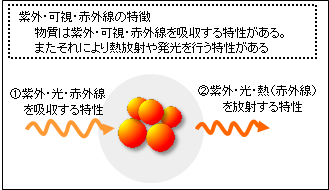Visible and ultraviolet characteristics
About the generation of light
When the temperature of an object causes the molecules and atoms to vibration, the electric charge vibration and electromagnetic waves are generated. Below 600°C, infrared rays are generated, and above that, visible light (which changes to red, orange, yellow, and white as the temperature increases) is generated.
Occurs due to orbital fluctuations of electrons within atoms
As mentioned in the previous section, infrared light absorption absorption to the resonance of atomic and molecular vibration, while shorter wavelengths such as visible light and ultraviolet light are generated by fluctuations in the orbital positions of electrons within atoms.
Within an atom, a fixed number of electrons depending on the element move in fixed orbits, but when an external stimulus (ultraviolet rays, X-rays, plasma, etc.) causes an electron to move (become excited) from a lower (inner) orbit to a higher (outer) orbit, it radiates energy when it moves back to the original lower orbit (inner). This is light (ultraviolet rays).
Examples of this type of light include fireworks (flame color reaction of metal), auroras, and fluorescent lights.
*For more details on the principles of visible light and ultraviolet light absorption and emission (atomic nuclei, electron orbits, etc.), click here.



